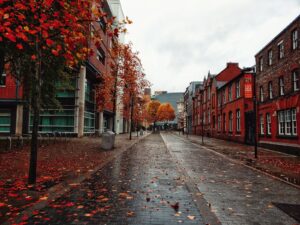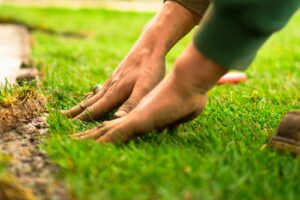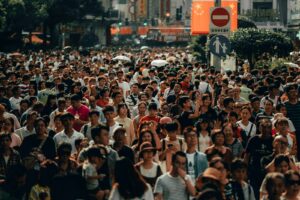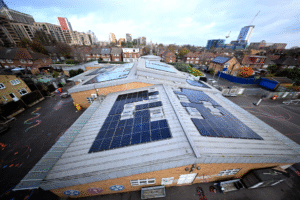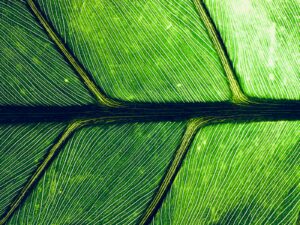New work at a groundbreaking Norwich gallery asks us to consider our impact on marine environments, our place on a shared planet, and narratives about oceans, origins, water and the future.
People say beauty is in the eye of the beholder. From where we’re standing, in the middle of a UK gallery that re-wrote the book on galleries, we’d say the same applies to art.
The Sainsbury Centre has plenty to write home about. This was the very first public commission won by Norman Foster + Partners – the architectural powerhouse responsible for some of Britain’s most iconic modern structures. As a big as an aircraft hangar, there’s no fixed route through its exhibitions, all pieces share equal space in the main Living Art area, leaving visitors to decide on how they engage and explore.
Published in 2023, A Handbook for Living Art is the institution’s guide to experiencing visual culture in a wildly unique way – inviting us to ‘meet’ pieces rather than simply gaze upon them. The text then asks us to ‘form your own relationships’ with whatever is on display. Director Jago Cooper tells us we’ll never be able to unread the pages, forever changing how we connect with galleries and museums.
Right now, the Sainsbury Centre, which is situated on the campus of the University of East Anglia, is also home to a groundbreaking climate and environment-aligned exhibition with elements spread throughout the huge facility. As usual, the inspiration is a simple question related to the world we live in, suggested by the public. Speaking on video call after the opening, Cooper explains more about Can The Seas Survive Us, which runs until 26th October.
‘The idea comes from a lot of questions people had about the ocean and sea, and climate change,’ he says. ‘The idea was let’s look at this but try and reverse the agency, and think of the planet like a living entity. Which it is. So now it becomes a question about whether it can survive us. This way, it gets us, as humans, to think as though we are residents in this other space which isn’t just ours.’
In reality, the endeavour is less an exhibition and more a series of exhibitions interlinked throughout the Centre. Take A World of Water, for example. The collection asks us to forget the inevitable rain that meets you at the UK seaside or on Wimbledon’s Centre Court, and consider what our planet would be like if there was no H20. Then it raises the terrifying spectre of a 21st Century which may be defined by increasing conflict drive by a need to secure this most precious natural resource.
Fascinatingly, this begins with one of England’s oldest maritime links, from Norfolk across the North Sea to the Netherlands. Today, it’s possible to make the journey overnight with a Stena Line ferry from Harwich in nearby Essex. But the connection between the UK’s easterly lowlands and those of continental Europe stretches back centuries. Fittingly, then, 250 years of art is included in the Centre’s latest opening, including contemporary pieces sourced from Dutch collections and practitioners, with the overall point being to emphasise the level of impact our seafaring-story-so-far has had on the sea itself.
Darwin In Paradise Camp is the UK premiere of Samoan artist Yuki Kihara’s dazzlingly colourful upcycled work. Using the oeuvre of 19th Century French painter Paul Gauguin as foundation, the message is clear – while close contact with our oceans has led to devastation, forming intimate bonds and relationships with marine ecosystems might just be able to save them.
Elsewhere, Sea Inside spotlights more intimate underwater spaces – physical, psychological, imaginary – and asks us to consider shared origins in the depths, Indigenous cultures and ways of life. This includes things we take from the seabed to display on land. The treasures we covet because they represent a world which, on paper at first, seems entirely removed from our own.
Moving beyond the Centre itself, ‘ecosystem futurists’ De Onkruidenier will hold a residency for the duration of Will The Seas, working alongside Norfolk communities by engaging in meaningful exchanges and activations, helping the public think, learn and understand nuances, details, opportunities and challenges connected to the very simple notion that the seas are in trouble, and if we do not act fast, once-thriving environments are at risk of becoming deserts. Totems of death, devoid of life.
‘They’re all exploring this question from completely different cultural perspectives and different time periods,’ Cooper says of the various elements that make up this bold project. ‘The oceans cover more than 70% of the planet; it is the life source of the natural world, an eternal expanse of more than a billion cubic kilometres of marine habitat.
‘Yet what do these seas say about the state of nature today and our relationship with it?,’ he continued. ‘From wind farms populating the North Sea and plastics filling the Pacific, to toxic algal blooms appearing and beautiful creatures disappearing, what really lies below the surface of these stories and ultimately: Can the Seas Survive Us?’
Image: Hiroshi Sugimoto, Devonian Period, 1992. Copyright Hiroshi Sugimoto, courtesy of Lisson Gallery
More on climate change:
Looks like rain: Vodafone and River Severn Partnership trial network-as-sensor nowcasting
Waitrose sets ‘new animal welfare benchmark’ with chicken policy
DUP votes against plans for Northern Irish climate change commissioner











